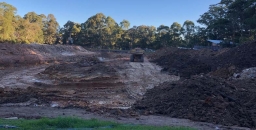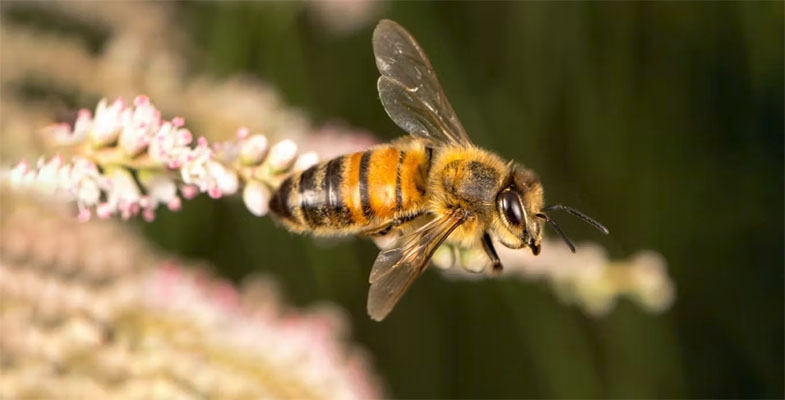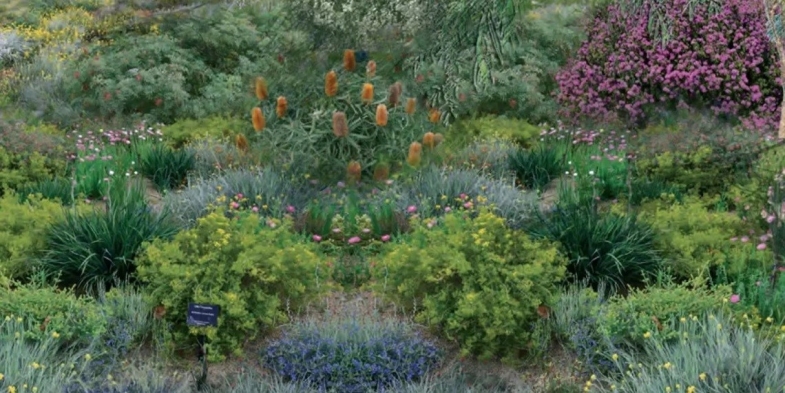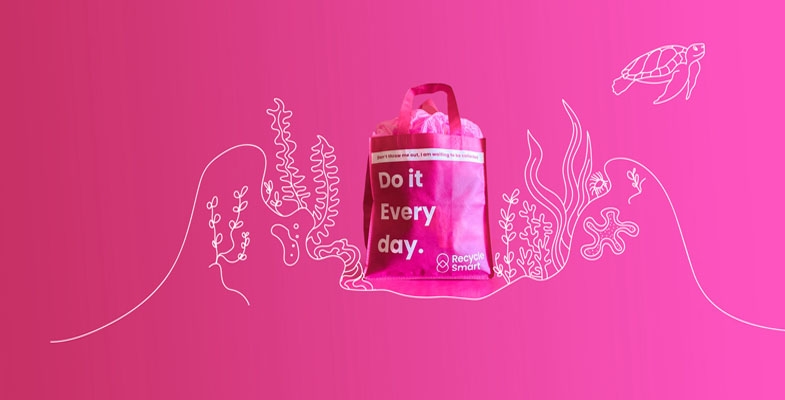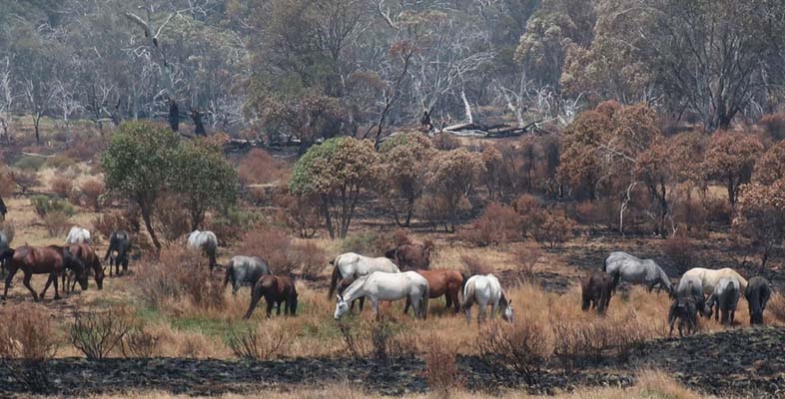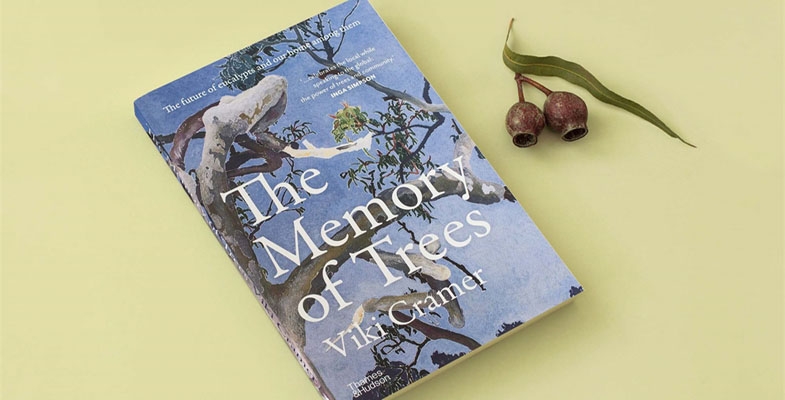STEP Matters 222
- Default
- Title
- Date
- Random
- Australia’s national parks, botanic gardens, wild places and green spaces are swarming with an invasive pest that is largely flying…Read More
- A group of residents in West Pymble took Ku-ring-gai Council to the Land and Environment Court for a judicial review…Read More
- The synthetic hockey surface was installed about 30 years ago and is now worn out. The Northern Sydney and Beaches…Read More
- There has been much angst expressed at Ku-ring-gai Council forums and meetings about the grandstand project. Sure there is a…Read More
- Typical low maintenance plantings on public land have low diversity, visual appeal and function. Monocultures of strappy plants such as…Read More
- At the August council meeting it was decided to trial the introduction of a new recycling service of items that…Read More
- Prepare to appreciate the world under your feet (well, your feet grounded on the earth, maybe not on a concrete…Read More
- Finally there is the prospect of real action on feral horses in Kosciuszko National Park – please make a submission by…Read More
- This book was of great interest having lived in Perth for 9 years and worked and travelled at length in…Read More
The feral flying under the radar: why we need to rethink European honeybees
Australia’s national parks, botanic gardens, wild places and green spaces are swarming with an invasive pest that is largely flying under the radar. This is yet another form of livestock, escaped from captivity and left to roam free.
Contrary to popular opinion, in Australia, feral colonies of the invasive European honeybee (Apis mellifera) are not 'wild', threatened with extinction or 'good' for the Australian environment. The truth is feral honeybees compete with native animals for food and habitat, disrupt native pollination systems and pose a serious biosecurity threat to our honey and pollination industries.
As ecologists working across Australia, we are acutely aware of the damage being done by invasive species. There is rarely a simple, single solution. But we need to move feral bees out of the 'too hard' basket.
The arrival and spread of the parasitic VarroaVarroa mite in New South Wales threatens to decimate honeybee colonies. So now is the time to rethink our relationship with the beloved European honeybee and target the ferals.
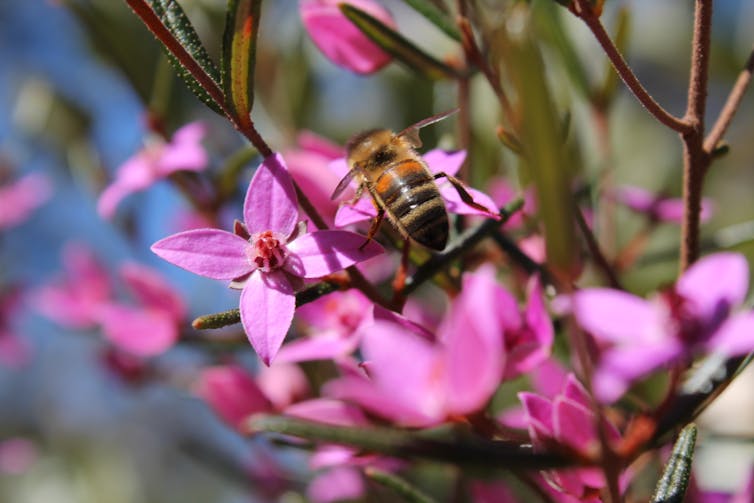
What makes a hive feral?
European honeybees turn feral when a managed hive produces a 'swarm'. This is a mass of bees that leaves the hive seeking a new nest. The swarm ultimately settles, either in a natural hollow or artificial structure such as a nesting box.
With up to 150 hives per square kilometre, Australia has among the highest feral honey bee densities in the world. In NSW, feral honeybees are listed as a 'key threatening process', but they lack such recognition elsewhere.

Feral honeybees have successfully invaded most land-based ecosystems across Australia, including woodlands, rainforests, mangrove-salt marsh, alpine and arid ecosystems.
They can efficiently harvest large volumes of nectar and pollen from native plants that would otherwise provide food for native animals, including birds, mammals and flower-visiting insects such as native bees. Their foraging activities alter seed production and reduce the genetic diversity of native plants while also pollinating weeds.
Unfortunately, feral honeybees are now the most common visitors to many native flowering plants.
Are feral bees useful in agriculture?
Feral honeybees can pollinate crops. But they compete with managed hives for nectar and pollen. They can also be an reservoir of honeybee pests and diseases such as the Varroa mite, which ultimately threaten crop production. That’s because many farms rely on honeybees from commercial hives to pollinate their crops.
So reducing feral honeybee density would benefit both honey production and the crop pollination industry, which is worth A$14 billion annually.
Improved management of feral honeybees would not only help to limit the biosecurity threat, but increase the availability of pollen and nectar for managed hives. It would also increase demand for managed honeybee pollination services for pollinator dependent crops.
What are our current options?
Tackling this issue will not be straightforward, due to the sheer extent of feral colony infestation and limited tools at the disposal of land managers.
If the current parasitic Varroa mite infestation in NSW spins out of control, it may reduce the number of feral hives, with benefits for the environment. Fewer feral hives would be good for the honey industry too.
Targeted strategies to remove feral colonies on a small scale do exist and are being applied in the Varroa mite emergency response. This includes the deployment of poison (fipronil) bait stations in areas exposed to the mite.
While this method seems to be effective, the extreme toxicity of fipronil to honeybees limits its use to areas that do not contain managed hives. In addition, the possible effects on non-target, native animals that feed on the bait, or poisoned hive remains, is still unstudied and requires careful investigation.
Where feral hives can be accessed, they can be physically removed. But in many ecosystems feral colonies are high up in trees, in difficult to access terrain. That, and their overwhelming numbers, makes removal impractical.
Another problem with hive removal is rapid recolonisation by uncontrolled swarming from managed hives and feral hives at the edges of the extermination area.
Taken together, there are currently no realistic options for the targeted large-scale removal of feral colonies across Australia’s vast natural ecosystems.
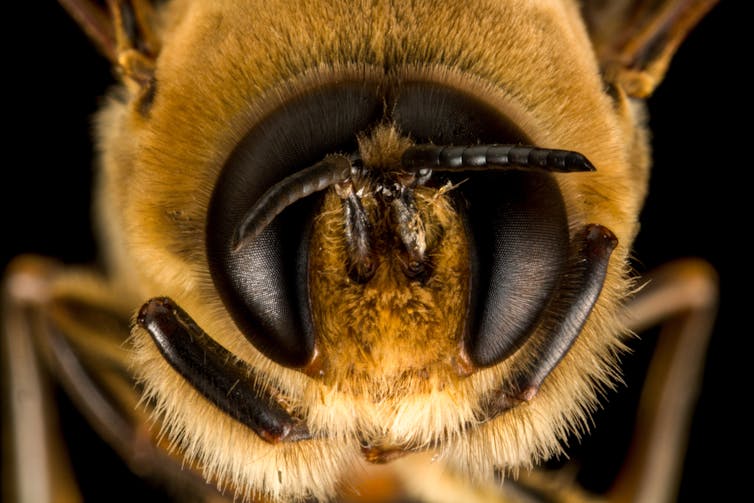
Where to now?
For too long, feral honeybees have had free reign over Australia’s natural environment. Given the substantial and known threats they pose to natural systems and industry, the time has come to develop effective and practical control measures.
Not only do we need to improve current strategies, we desperately need to develop new ones.
One promising example is the use of traps to catch bee swarms, and such work is underway in Victoria’s Macedon Ranges. However, this might be prohibitively expensive at larger scales.
Existing strategies for other animals may be a good starting place. For example, the practice of using pheromones to capture cane toad tadpoles might be applied to drones (male bees) and swarms. Once strategies are developed we can model a combination of approaches to uncover the best one for each case.
Developing sustainable control measures should be a priority right now and should result in a win-win for industry, biosecurity and native ecosystems.
If there is something to learn from the latest Varroa incursion, it is that we cannot ignore the risks feral honeybees pose any longer. We don’t know how to control them in Australia yet, but it is for lack of trying.
We would like to acknowledge the substantial contribution made by environmental scientist and beekeeper Cormac Farrell to the development of this article.![]()
Amy-Marie Gilpin, Research Fellow, Ecology, Western Sydney University; James B. Dorey, Adjunct Lecturer, Flinders University; Katja Hogendoorn, Research fellow, University of Adelaide, and Kit Prendergast, Native bee ecologist, Curtin University
This article is republished from The Conversation under a Creative Commons license. Read the original article.
Norman Griffiths court case: a loss for the community and the environment
A group of residents in West Pymble took Ku-ring-gai Council to the Land and Environment Court for a judicial review of the decision to proceed with the construction of a stormwater mitigation system and synthetic turf soccer field at Norman Griffiths Oval. A group called Natural Grass at Norman Griffiths (NGANG Ltd) was registered in order to conduct the case and receive community donations.
This follows council’s decision to proceed with the project in early March 2023 after the release of the Review of Environmental Factors (REF), version 8, two weeks earlier. The haste in starting work was a cause of much frustration in the community and a fiery public forum meeting. After all we had had to wait over 14 months to see the details of the design and the REF. The time available to review the REF was inadequate; much shorter than promised. The councillors dismissed the relevance of the environmental issues raised by the community on the grounds that the REF provided assurance that the issues were not significant.
An injunction was accepted by the court to stop construction past the stormwater mitigation system stage until the case was decided. The case was expedited so there would not be a long delay before contractors started laying the turf.
Over $120,000 was raised towards the costs of the case and expert witnesses. This is a demonstration of the high level of public interest and concern about the use of synthetic turf.
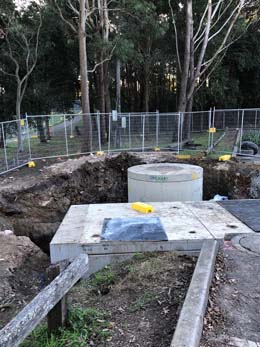
The gross pollution trap and diversion to underground detention ... but what about the water flow from the hill above the field?
Last minute amendment to the REF
NGANG was right! The time allowed to review the REF was too short. The REF was missing some of the analysis required about environmental impacts following an amendment to the Environmental Planning and Assessment Act 1979 (EP&A Act). Council decided it was okay to make a last minute amendments so version 9 was published on
4 July. Sadly, the L&E Court did not see that this expediency was an issue that could prevent the project proceeding but it is another demonstration of council’s poor governance.
Court case begins on 2 August
The main arguments submitted by NGANG were that:
Not all required environmental issues were considered to the fullest possible extent
The case was a judicial review where the relevant task is the consideration of the decision made by council. The judgement explained that a challenge may be made on the basis that the decision-maker should, acting reasonably, have made some additional inquiries. Expert evidence as to what the outcome of those inquiries would have been is, in some cases, admissible. Expert evidence was provided by Dr Scott Wilson, a microplastics expert and Dr Martens, a stormwater expert. Council also engaged three experts on flooding, pollution and ecology.
NGANG argued that council had not examined and taken into account to the fullest extent reasonably possible all matters likely to affect the environment following the installation of the synthetic turf. This is a duty imposed under section 5.5 of the EP&A Act.
NGANG’s case was that there should have been inquiries covering:
- a pollutant load study to assess microplastic pollution;
- a flood study to understand the flood impacts on the area and whether the stormwater detention proposed would function in the manner intended; and
- an investigation and understanding of where the overland stormwater flow path would be located in circumstances of an extreme rainfall (1 in 100 year event); and the investigation of the impact of the overland flow path upon the Sydney Turpentine Ironbark Forest below the field.
There was disagreement between NGANG’s expert and council as to the adequacy pf the onsite stormwater detention system (OSD). As an observer of the case, it appeared that much of the discussion of the OSD was at cross-purposes in referring to the existing system versus the new system. A new system had to be installed because the hard surface of the synthetic turf could not retain the stormwater. The old grass surface acted as the OSD.
The court ruled that the judicial review could not consider the merits of council’s decision and could only review whether it was acting reasonably. The judge rejected the evidence of Dr Martens and Dr Wilson that was sought to be tendered to establish the duty to make further inquiries in the circumstances of this case.
Stormwater system
Dr Martens advised on the requirement to undertake a study to understand the flood impacts on the area and whether the stormwater detention proposed would function in the manner intended. The report in the REF by Optimal Stormwater Ltd determined that the proposed system was capable of operating in the manner and to the specifications for which it was designed. The judge ruled that, in the circumstances, there was nothing on its face that would cause a decision-maker to consider that the opinions expressed were not reliable or not properly formed. The suggestion that the council was not entitled to take ‘at face value’ the information in the Optimal Report has no foundation. The question remains as to whether the specifications are adequate.
Microplastics
The ruling in relation to this issue indicates that the wrong question was being asked. On the evidence contained in the REF there is a goal of minimising microplastic loss from the synthetic field and identifies the measures to be adopted to achieve such goal. It is acknowledged that 100% capture is not possible, especially in extreme rainfall events but no further inquiries were recommended.
There is an obligation to commission an environmental impact statement
The other main ground argued by NGANG was the failure to comply with section 5.7(1) of the EP&A Act. This provision contains within it two obligations, first to determine whether the activity has a significant effect on the environment and secondly, if so, to not carry out the activity or grant an approval until it has obtained and considered an environmental impact statement (EIS):
In submissions NGANG formulated this ground on three bases:
- If the court found on the evidence that there was a prospect that the flood mitigation scheme being an integral part of the activity did not work as asserted by the manufacturer, either in not acting as an OSD system or not sufficiently capturing the overland flows, the court would find, on the evidence, that the proposal was likely to significantly affect the environment.
- If the court found on the evidence that the OSD system would not work as designed the infill and microplastics will not be sufficiently captured or retained on-site and will be washed down into the receiving environment, including Quarry Creek.
- A separate impact which has not been assessed from the overland flow path, which is the water diverting to the south over the field and then discharging into Quarry Creek, and the potential impacts on the adjoining STIF and Quarry Creek from that overland flow.
The judgement stated that consideration of significant impact on the environment is so broad and far reaching that it was unlikely to be determined as an objective fact by the court in judicial review proceedings. Therefore the question of whether an activity is likely to significantly affect the environment is not an objective jurisdictional fact but is a matter for the determining authority (the council) to determine acting reasonably. It seems that the precautionary principle doesn’t have any weight in this case whereby uncertainty does not justify inaction.
In this case the Judge found that council had acted reasonably. Statements by Dr Martens that the impacts may occur were insufficient to permit a finding of a likely significant effect on the environment. Modelling of changes in the hydraulic performance had not been done to enable the Court to make its own assessment.
Full steam ahead but what will happen when the plastic grass needs to be replaced?
So sadly, the construction of the synthetic turf field is now proceeding at maximum pace with completion possible by the end of this year.
The synthetic surface will not last forever, the lifetime with normal levels of use is 8 to 10 years. The question is, will council be able to replace the surface with synthetic turf? Now that a stormwater mitigation system is in place the flood risk from the field that acted as a stormwater detention basin has been substantially ameliorated. So it would be an excellent base for a natural grass field.
Currently there is no effective system for recycling the materials in synthetic turf so the large volume of material ends up in landfill. The evidence of environmental harm from the use of synthetic turf overseas is growing as is community opposition to its use because of the heat and injury risks. Several states in the USA have banned future installations of artificial turf because it contains dangerous chemicals such as PFAS compounds.
The Chief Scientist’s review into the design, use and impacts of synthetic turf in public open spaces highlighted the need for more research into human health and environmental impacts. Microplastics are a becoming more and more pervasive in our waterways. They can also interact with soil fauna, affecting their health and soil functions. Synthetic turf breaks down with people running over it and general deterioration from sunlight exposure. This breakdown increases as the turf blades age. The Norman Griffiths REF acknowledges that it is not possible to capture all the microplastics that will break off the turf. They will be washed off the field by rain but also blown away by wind due their small size of less than 5 mm.
We understand that council will be testing Quarry Creek for microplastics but the soil within the STIF forest and bushland below the field should also be tested.
The outcome of the chemical analysis must be taken into account when the replacement of the field surface is considered. Also we hope that the guidelines developed from the Chief Scientist’s review will provide meaningful decision making processes.
Ultimately the question that has to be asked is about the appropriateness of adding a large area of plastic to the environment when there is a viable natural alternative; that is real grass!
There has been such strong community opposition to synthetic turf at Norman Griffiths and in other parts of Sydney it will be difficult for councils to ignore in making future decisions.
Ku-ring-gai High School hockey field
The synthetic hockey surface was installed about 30 years ago and is now worn out. The Northern Sydney and Beaches Hockey Association (NSBHA) has been working on a project to renew the surface and upgrade the players’ amenities. They originally proposed a totally new facility at Barra Brui oval in St Ives on the edge of Garigal National Park. That was eventually knocked back because car parking space was too limited. So the project is proceeding at Ku-ring-gai High.
The project is being funded through a NSW Office of Sport – Sporting infrastructure Grants ($2,720,000), NSBHA funding ($480,000) and a Ku-ring-gai Council contribution for specific carpark works ($1,000,000), giving a total of $4,200,000.
The council meeting in August voted to proceed with the joint project at Ku-ring-gai High. We cannot provide more details as all the reports presented to the meeting were confidential. The meeting minutes note that council is accepting the risks and costs associated with the project and the general manager is to be the delegated authority to execute the draft Heads of Agreement on behalf of council. What are the ‘risks and costs’? The grants are intended to cover the construction and installation costs.
Car parking is an unknown element of the project. A new parking area on the school grounds requires approval under Part IV of the Environmental Planning and Assessment Act 1979, for which council would be responsible. It is hard to see how the car parking can be increased without affecting the broad area of bushland in the school grounds that abuts Ku-ring-gai Chase National Park and contains some rare plants.
The meeting minutes note that the development of the field will occur irrespective of whether development consent is obtained for the car park upgrade. In the staff report for the meeting it is stated that the project is justified because the project will lead to better containment of impacts on-site and hence reduced impact on the local community. We can’t see how impact will be reduced with more traffic on Bobbin Head Road. If the car park upgrade does not occur there will be more demand for parking on Bobbin Head Road.
North Turramurra Recreation Area grandstand
There has been much angst expressed at Ku-ring-gai Council forums and meetings about the grandstand project. Sure there is a need to improve the facilities at the ground but the proposal is over the top. The cost of the proposed 300 seat grandstand plus café, change rooms, offices, treatment rooms, corporate and media facilities has gone beyond the estimate obtained in August 2022 of $5.5 million. A recent quote obtained by Council was $7.76 million. The proponent, the Northern Suburbs Football Association (NSFA) thinks the $7.7 million figure is overly conservative, but $5.5 million is still enormous!
At the council meeting on 28 July a detailed debate occurred over whether council should proceed with a Heads of Agreement and accept the risks, costs and benefits. The motion put before the meeting noted that the project may not be financially feasible but is driven by ‘economic, social and environmental value offered to the community’. This is an odd statement as the community has objected vociferously about the social impacts in particular (increased traffic, noise, bushfire risk).
The NFSA is bearing the construction and operating costs. They were advised that two grants were approved, one a Female Friendly Community Sports Grant for $500,000 and the other from Multi-Sport Community Facility Fund for $3.6 million. So the NSFA is fronting up at least $1.4 million.
There are still several concerns with this ambitious project:
- The cost looks likely to be higher than covered by funding.
- As pointed out by Cedric Spencer in a motion presented to the August council meeting, it is not clear that the grant applications had council’s consent. This is a prerequisite to grant approval.
- Council will seek assurance that a grant that benefits football, is not inconsistent with the key objectives of the Multi-Sport Community Facility Fund.
- The long-term master planning for NTRA when it was developed in 2011 never contemplated a facility of the scale and nature proposed by NSFA. It was a multi-year project funded from development contributions, general revenue and a special rate variation levied on all residents of Ku-ring-gai. The project cost some $30 million. It was not carried out for the benefit of one dominant sporting group which is what it would become with the implementation of the grandstand proposal. The NSFA would be the primary users of this site at the expense of all other users.
- There is conflicting information about the longer term plans for the site in reference to the amount of usage and the traffic that would be generated. It seems a very expensive project if, as declared by the NSFA, the usage of the three fields is not going to increase.
- There are rumours that there are intentions to convert one or more of the other two playing fields to synthetic turf, which would be strongly opposed.
Ku-ring-gai Council is trialling a woody meadow project
Typical low maintenance plantings on public land have low diversity, visual appeal and function. Monocultures of strappy plants such as Lomandra longifolia and Dianella or single shrub species like saltbush are often the plants of choice that provide little contribution to biodiversity.
Since 2015 Melbourne University, in collaboration with the University of Sheffield, has been trialling a novel low-cost and resilient approach to urban greening, using natural shrubland structures as templates to create beautiful, diverse plantings of Australian shrubs which are maintained through coppicing.
The idea is that coppicing (hard pruning to 10 to 20 cm high) every two to four years will promote flowering and rapid canopy closure to exclude weeds and reduce maintenance. With their high number of flowers, woody meadows encourage insects such as native bees, small birds and other wildlife.
Woody meadows are highly adaptable and can be used in a wide range of urban settings including railway easements and roadside verges, roundabouts, parks and gardens, and as part of water sensitive urban designs like raingardens and retention basins. Their low water use and maintenance requirements, coupled with high visual appeal and adaptability make them an attractive, cost-effective solution for councils and urban land managers challenged by climate change and often limited green space funding.
Councils, government agencies and developers are embracing this idea, with more than 6,000 m2 of woody meadows established around Australia that include approximately 40,000 plants from 150 different species.
With more 25,000 m2 of plantings planned for 2023, you’ll likely be seeing woody meadows popping up in your neighbourhood soon.
In August council’s environmental staff and 14 local volunteers planted 400 tube stock in Transmission Park in St Ives Chase to create the trial woody meadow. The plantings will develop over the next 12 to 18 months and staff will monitor the site to test whether biodiversity is increasing through more sightings of insects, birds and animals.
The evidence from this initial planting will help decide whether to extend woody meadows to other public land in Ku-ring-gai.
A new recycling service has come to Ku-ring-gai
At the August council meeting it was decided to trial the introduction of a new recycling service of items that are currently not included in council’s recycling contract. After a two year trial period its cost effectiveness will be assessed. Items covered by the service include:
- soft plastics
- clothing and linen
- small household appliances such as electrical tools, hairdryers, irons, toasters, laptops and game consoles
- coffee capsules, batteries, medicine containers, printer cartridges and sealed paint tins
Residents are able to book a collection from their home direct to the recycling depot. Residents can use their own bags to separate recyclable items from their general waste. Bags can also be provided by RecycleSmart. Make your booking via the RecyleSmart app.
Collection of larger items can be booked as an add-on to an existing pickup.
Book review: Underground Lovers: Encounters with Fungi
Prepare to appreciate the world under your feet (well, your feet grounded on the earth, maybe not on a concrete slab).
There is a network of mycelia that belong to their own kingdom: Fungus. Lacking chlorophyll, they grow from the tips of microscopic hyphae and digest nutrients externally (underground) before absorbing them into the mycelium.
One hypha is a microscopic filament but together they form a fungus mycelium (the network). Hyphae can not only branch but also fuse, or ‘anastomose’ and exchange genetic material. The cell walls are made of chitin, a hardness also found in arthropod exoskeletons. The mycelial scaffold essentially mirrors exponentially the life forms above ground. Mycelial networks bind soil particles while also aerating the soil, creating spaces in the soil. This architecture allows water to penetrate soil’s deepest horizons.
The fungi also form alliances with plants, or even digest other organisms. Fungi and algae, forming lichens, create soil on rock – as on exposed rock left by the retreating Vatnajökull ice cap in Iceland.
Many plants depend on mycorrhizal fungi – the fungi forming beneficial relations with roots: hyphae extend the roots’ absorbable surface; the tree provides sugars from photosynthesis while the mycorrhizal fungi make nitrogen and phosphorus available to the tree.
The author gives us good reason not to clear-fell, nor burn our forests in super-hot conflagrations, nor overheat the earth with global warming, nor over-fertilise and apply weedicides to our monocrops; even the high-velocity gale of the leaf-blower dislodges spores, let alone grasshoppers, beetles and frogs. It kills the fungi.
Some ‘old growth’ trees reach hundreds of years of age; but the fungi beneath them are at least as long-lived. Old forests support a greater diversity of fungi than young, or obliterated, forests.
Interesting allusions – Pouliot mentions her US Northwest rented V8 Dodge Charger not being the ideal field vehicle ‘with the clearance of an echidna’.
The ninth chapter Women as Keepers of Fungal Lure fills a gap. I searched for books on fungi and nearly all the citations are of men’s studies.
The tenth chapter Restoring Fungi is apposite given the fungus talks by Emeritus Prof Michael Gillings and Vanessa McPherson of Macquarie University. They observed that sites where works such as a drainage pipe had been laid hosted far fewer fungi than undisturbed (or merely weeded) sites. A property owner demonstrates that we need to create diversity and reduce stresses. On her property she supplied diverse organic matter of different species, size and age, and eliminated tilling, digging, excavating, heavy machinery and even hard hooves of stock.
Mistletoe contributes to restoration, providing nectar for butterflies, gliders and possums; and when it dies its leaves enrich the soil with phosphorus, nitrogen and potassium.
Lichens colonise bare earth and are part of the cryptogamic crusts essential for forming a film that reduces wind and water erosion. This crust of fungi, algae, cyanobacteria and mosses over the soil fixes carbon and nitrogen – and is destroyed by stock. The property owner, Kazuko, observes ‘We should be starting with soil crusts rather than trees when restoring ecosystems’.
Fungi have infiltrated Landcare! Officially restoring waterways, agricultural and natural areas since 1989, the movement now recognises the necessity of healthy fungi.
The author has travelled the globe and gives examples of mycophiles’ world-wide fungus hunting throughout the book. There is a species register with common and scientific names of fungi and lichens, plants and animals; a glossary, selected sources and an index. The editor might have picked up the constant misuse of ‘among’ and ‘between’. Despite the listing of 11 images, there are no photographs. Our desire for pictures and descriptions of so many intriguing species and descriptions probably needs a mini-encyclopaedia!
Alison Pouliot, NewSouth Publishing, 2023; 278pp (reviewed by Margery Street)
Feral horses in Kosciuszko
Finally there is the prospect of real action on feral horses in Kosciuszko National Park – please make a submission by 11 September 2023.
Penny Sharpe, NSW Environment Minister has announced a proposal to amend the Kosciuszko Wild Horse Management Plan to permit aerial culling of feral horses. There is an urgent need for action as the number of horses has been increasing rapidly. The government says the most recent official count estimate was that there are between 14,501 and 23,535 feral horses across the park.
Under the management plan agreed to under the previous government, the number of horses had to be reduced to 3,000 by 2027 in order to limit the damage they are doing to the sensitive alpine ecosystems. About 30 endangered native species and their habitats are at risk of extinction due to introduced animals, including wild horses.
However the current management methods used such as on ground shooting, trapping and rehoming are not effective. The numbers are still increasing. More effective action must be taken before the situation gets even more out of control.
The proposal is open for submissions until 11 September. Submissions need only be short. There are various ways to submit, listed on the government's Have your Say page.
Book review: The Memory of Trees
This book was of great interest having lived in Perth for 9 years and worked and travelled at length in WA for more than 40 years, including in many areas covered in the book, set predominantly in the south-west and south of the state. It's written by freelance ecologist and writer Vicki Cramer, whose research and publications through institutes like Curtin University and the CSIRO span a wide range of WA ecology, from bats and marsupials to Western Australia’s management, exploitation and clearing of eucalypt forests. In 2021 she was awarded a Dahl Fellowship from the charitable organisation Eucalypt Australia. Though set almost entirely in WA, the book mirrors the natural vegetation situation in other states and the threats it faces.
The Memory of Trees is divided into long, quite detailed chapters dealing with topics such as Jarrah forests and their threats, the West Australian Wheatbelt and salinity, the amazing Great Western Woodlands with their vast areas of trees growing in climates so dry that trees really shouldn’t grow at all. And, of extreme importance for us in NSW, the subject of bushfire, of hazard reduction and cultural burns and their history and arguments for and against. Relevant to fire and overshadowing everything covered in the book of course is climate change, the biggest mover of the goalposts that we face.
How many plant species are native to the south-west of WA? Well, the book cites 8379 would you believe (but of course new species are discovered every year so that’s by no means the final figure). Of that number, 1750 are native to Fitzgerald River National Park for example, a big park of nearly 3,000 km2 flanking WA’s south coast, big yes, but that’s very, very rich! (Blue Mountains World Heritage with around 1500 species is three times as big). And then the Stirling Ranges: full of endemic species, some of them isolated to individual peaks. These are examples of the fragile communities surviving as large islands of natural vegetation flanked or surrounded by land cleared for agriculture? What species have been lost through the clearing process? We will never know the full number, plant or animal.
Stirling Ranges and Fitzgerald River are flanked by the WA Wheatbelt. Vast areas of forest and woodland were cleared through waves of settlement, and managed on a broadacre basis with no treed remnants allowed to remain that get in the way of the massive harvesters. Farms have merged over time and families have moved away, much as is happening in Europe. The ancient impoverished wheatbelt soils were boosted, and have to be regularly topped up with superphosphate and trace elements. Natural vegetation over most of the wheatbelt is restricted to corridors and fringes along boundaries and roadways, plus isolated small copses. Mass tree removal, their roots no longer pumping, led to gradual rise in salinity – covered by a chapter in the book that highlights the recovery efforts of landowners and community groups but also political sidestepping, ignorance and neglect. Governments like to bypass salinity, highlighting grain yields, but a brief Google search will tell you that the WA wheatbelt yields a ball park figure of around 2 tonnes of grain per hectare – Ukraine by comparison, in its heyday, achieved roughly double that.
The Jarrah forests, featuring Eucalyptus marginata, were a backbone to WA’s historic economy. The rich, deep red, termite resistant timber is hard to source today except through recycling, but it was used in building and construction, in termite proof railway sleepers and in flooring and furniture, and it was exported globally. But it grows on iron and alumina rich laterite terrain large areas of which have been mined for bauxite. Bauxite, a chemically extreme end member of a soil profile, is typically only a few metres thick and so vast areas have to be stripped and mined to yield a commercial tonnage. Companies however are obligated to stockpile and restore the surface material, and the author describes traverses with colleagues in areas ranging from pristine and even rare old growth forest to sites in various stages of restoration. But one comes away with the impression that nothing can truly replace the lost forests. And then of course there’s climate change pushing winter rainfall southwards, and Phytophthora dieback!
Now for the Great Western Woodlands: these are truly vast but exceptionally vulnerable, made up essentially of eucalypt species some of which recover from fire, like the numerous species of mallee, while others are obligate seeders and are incinerated. If you’ve travelled the wheatbelt and the southern goldfields you’ll be familiar with the copper-red trunks of salmon gums. If you’ve driven east of Norseman you’ll have seen fine examples of Great Western Woodland, and perhaps be stunned to learn that the seemingly healthy trees are growing in less than 300mm mean annual rainfall. The author's field descriptions in areas east of the wheatbelt town of Hyden are both illuminating and saddening: overall the vast woodlands are threatened by climate change, reduced rainfall, human activity and most especially by fire.
Later in the book the author veers towards positive aspects: the Gondwana Link and the Nowanup Cultural Community. Gondwana link, which involves Bush Heritage among other groups, acquires land to revegetate to eventually form a chain of natural vegetation from the coastal forests of the south-west 1000km to the east to join up with the Great Western Woodland. Nowanup on the other hand was established to rally behind and promote Noongar cultural elements of which include cultural burning, which is perhaps the only way to mitigate and soften the devastating effects of climate change and fire on the woodlands and forests within a realistic time frame.
Viki Cramer, Thames and Hudson, 2023, paperback, 292 pp (reviewed by John Martyn)


